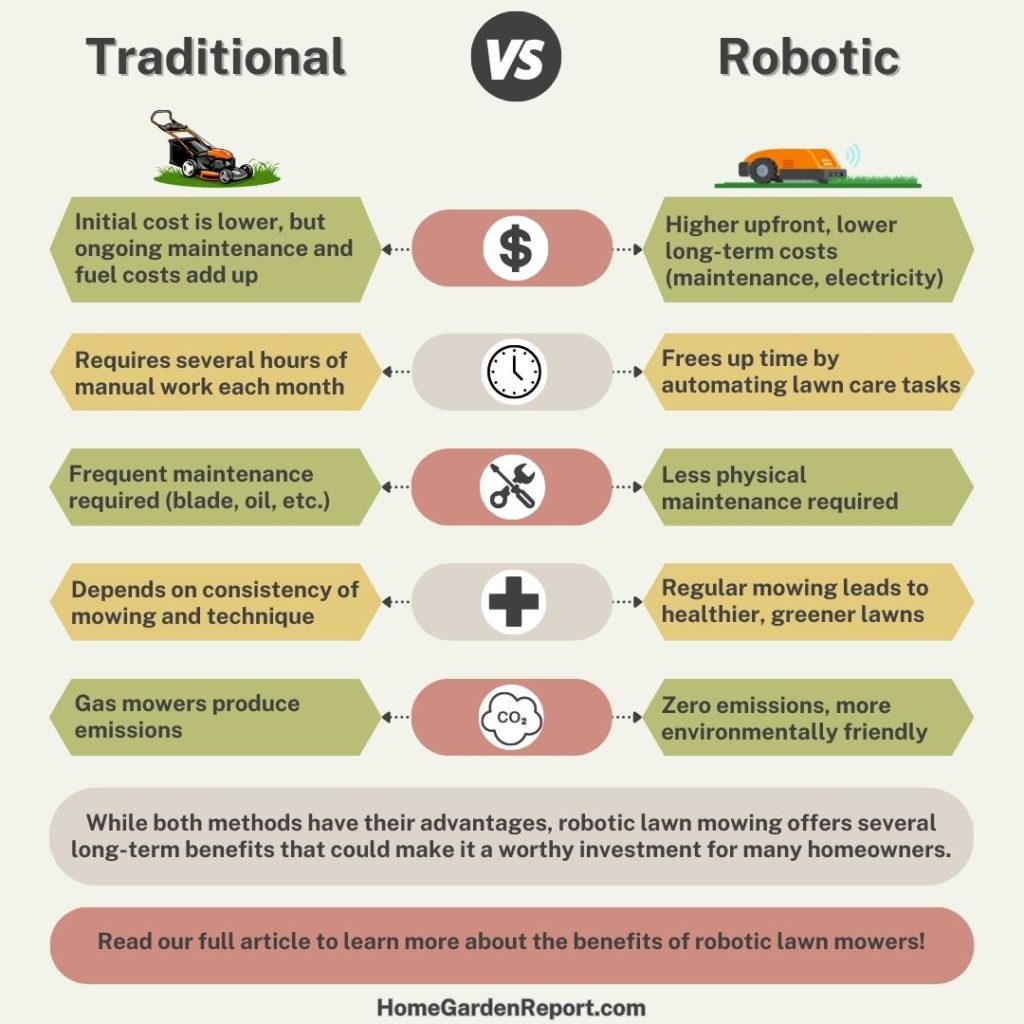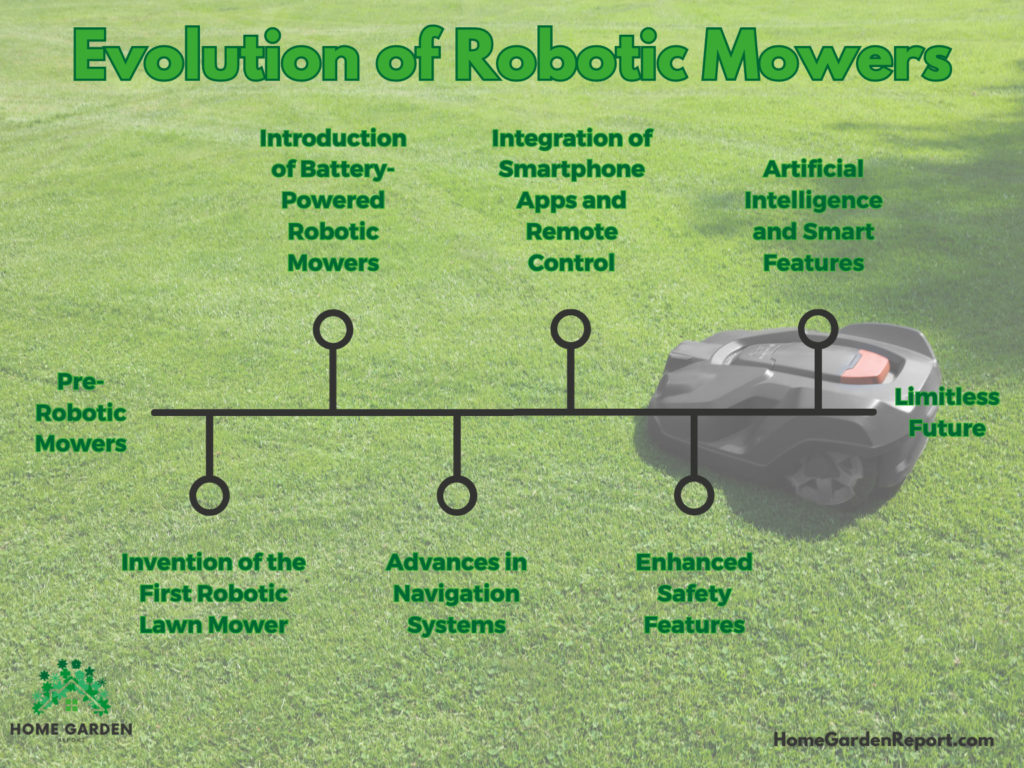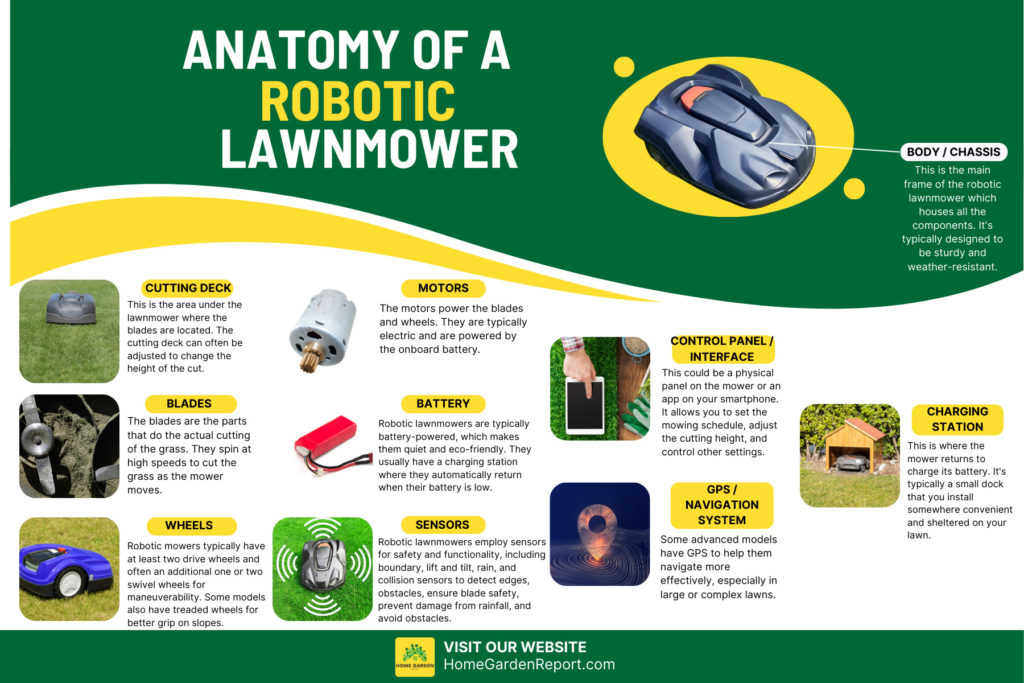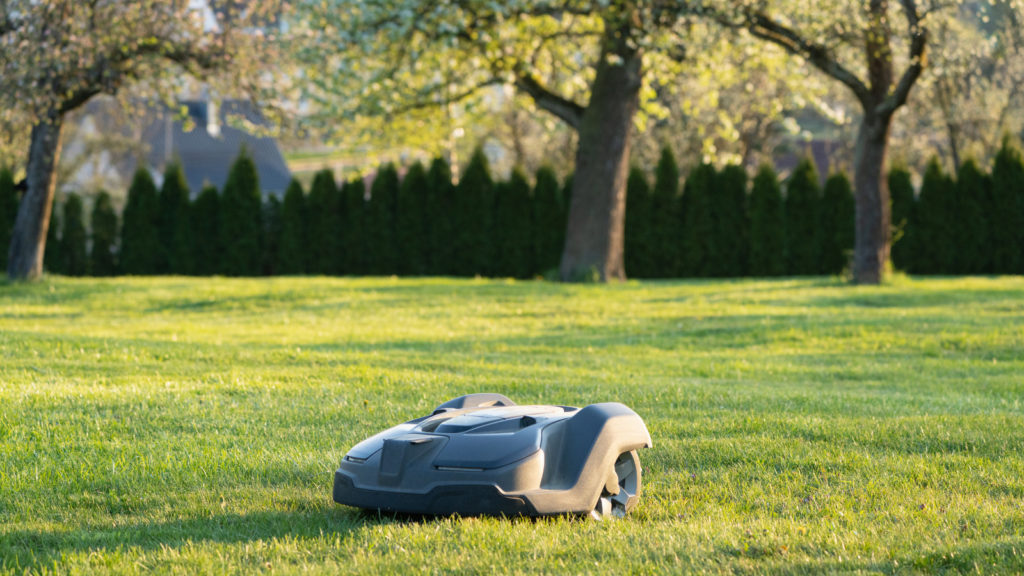
In an era where convenience and automation have transformed how we approach tasks, a growing trend has steadily made its way into the home gardening sector – the robotic lawn mower. Imagine kicking back with a cool drink, enjoying your weekend, while your lawn is being meticulously trimmed to perfection, without you lifting a finger. Sounds like a dream? Not anymore, thanks to the advent of robotic lawn mowers.

Just as household chores have seen the influence of technology, with robotic vacuum cleaners becoming a common sight in many homes, gardening tasks haven’t been left behind. The robotic lawn mower, a marvel of modern innovation, is poised to change our perspective on lawn maintenance, turning it from a time-consuming chore to a hands-off, automated task.
The rising popularity of these automated lawn mowers is fueled by our increasingly busy lives, the appeal of smart home technology, and an ongoing quest for more sustainable practices. Not to mention, there’s a certain ‘cool factor’ associated with owning what can essentially be considered a lawn-mowing robot.
However, with any novel technology comes a multitude of questions: How do robotic lawn mowers work? Are they as efficient as they claim to be? Most importantly, are they worth the investment, or are they just another tech fad? In this blog post, we’ll explore these questions, delve into the evolution of robotic lawn mowers, weigh the pros and cons, and compare some of the leading models in the market. By the end of this journey, you’ll have a solid understanding of whether investing in a robotic lawn mower is the right choice for you.
The Evolution of Robotic Lawn Mowers
It’s fascinating to see how technology evolves over time, and the story of robotic lawn mowers is no exception. Their journey from inception to their current state-of-the-art designs showcases the ingenuity of human innovation.

The first automated lawn mower was patented as early as 1969 by a certain John Reiger. This early invention, however, didn’t resemble the compact, high-tech robotic mowers we see today. The idea really started to take root in the 1990s, when companies like Husqvarna launched the first commercially available robotic lawn mowers. These first generation devices were, admittedly, far from perfect – they were quite expensive, required complex setup, and their efficiency left much to be desired.
Fast forward to the mid-2000s, and we see robotic lawn mowers starting to gain some traction, albeit primarily in Europe. Technological advancements allowed these machines to become more reliable, quieter, and increasingly autonomous, opening up a whole new way of maintaining lawns.
In the last decade, the rise of smart home technology gave another significant boost to robotic mowers. With smartphones becoming ubiquitous, the ability to control and monitor a lawn mower remotely added a layer of convenience that was hard to resist. Modern robotic mowers now come equipped with GPS navigation, smartphone integration, and even AI-powered technology that enables them to learn and adapt to the specific layout of your lawn.
From humble beginnings to smart, autonomous machines, robotic lawn mowers have come a long way. As we continue to embrace automation in our daily lives, these high-tech gardening aids are only likely to become more sophisticated and efficient. But, does a high-tech approach necessarily translate to better lawn maintenance? Let’s mow over the specifics of how these futuristic machines function in the next section.
How Does a Robotic Lawn Mower Work?

With their sleek designs and silent operation, you might wonder how exactly these robotic mowers manage to autonomously navigate and groom your lawn to perfection. Well, let’s delve into the inner workings of these ingenious machines.
At the heart of every robotic lawn mower is an onboard computer, sensors, and a rechargeable battery. The onboard computer houses the programming that enables the mower to operate autonomously, navigate your lawn, and return to its docking station when it needs to recharge or when its work is complete.
Sensors play a crucial role in ensuring the mower navigates safely and efficiently. Obstacle sensors prevent the mower from bumping into anything in its path, be it a garden gnome or your pet dog, by stopping or altering its course when it detects an object. Some high-end models also feature rain sensors, pausing operations when it starts to rain and resuming once conditions improve.
Navigation technology varies among different models. Some robotic mowers use an installed boundary wire to define the area to be mowed. The wire, laid around the perimeter of your lawn and around any obstacles, emits a signal that the mower uses to identify its boundaries. More advanced models use GPS navigation or even AI technology to map your lawn and improve their efficiency over time.
The robotic mower trims the grass with spinning blades located underneath the machine. Rather than cutting the grass in one go like traditional mowers, robotic mowers work by consistently trimming your grass over time, maintaining your lawn at a set height and leaving fine clippings that naturally compost into the lawn, providing beneficial nutrients.
But as with any technology, robotic lawn mowers have their strengths and weaknesses. Next, we’ll take a closer look at the advantages and challenges of opting for a robotic solution to your lawn maintenance.
The Pros of Using a Robotic Lawn Mower
The appeal of robotic lawn mowers is not hard to grasp. These smart machines offer a variety of advantages that make them an attractive choice for lawn maintenance. Let’s delve into the key benefits.
1. Convenience:
Perhaps the most significant advantage is the convenience factor. Once set up, robotic mowers work autonomously, freeing up your time for other tasks or leisure activities. You can schedule your mower to work at specific times, even when you’re not at home, ensuring a well-kept lawn with minimal effort on your part.
2. Consistency:
Robotic mowers work on a regular schedule and maintain your lawn at a consistent height, leading to a healthier and more attractive lawn. Their continuous, regular trimming also promotes denser grass growth, enhancing the lush look of your lawn.
3. Time Saving:
Traditional lawn mowing can be a time-consuming task, particularly for larger lawns. A robotic mower can save you significant time each week, which you can use to engage in activities you enjoy or tackle other gardening tasks.
4. Eco-Friendly:
Unlike many traditional mowers, robotic lawn mowers are electric and produce no harmful emissions. Additionally, the fine grass clippings they produce are left on the lawn to decompose, providing a natural fertilizer and reducing waste.
5. Noise Reduction:
Robotic mowers are considerably quieter than their traditional counterparts. This makes them ideal for use at any time of the day or night, without causing disruption to your household or neighbors.
While these benefits are compelling, it’s crucial to remember that no solution is perfect for everyone. In the next section, we’ll discuss some potential challenges and considerations when deciding whether a robotic lawn mower is the right choice for you.
The Cons of Using a Robotic Lawn Mower
While robotic lawn mowers come with a host of advantages, it’s important to balance the benefits with an understanding of their limitations and potential drawbacks.
1. Initial Cost:
One of the most significant barriers to entry is the upfront cost. Robotic lawn mowers are more expensive than traditional push mowers. While there’s a potential to recoup this cost over time through saved labor and maintenance costs, the initial investment can be steep.
2. Complex Lawn Layouts:
Robotic lawn mowers work best on flat, open areas. If your lawn has a lot of slopes, undulations, tight corners, or numerous obstacles like trees, flower beds, or garden decorations, the mower may struggle to navigate and mow efficiently. Some high-end models handle complex landscapes better than others, but generally, a very intricate garden layout might pose a challenge.
3. Size Limitations:
Most robotic mowers are designed to handle lawns up to a certain size. If you have a particularly large lawn, you might need a high-end (and more expensive) model, or even multiple mowers, to cover the entire area.
4. Maintenance and Setup:
While less labor-intensive than traditional mowers, robotic mowers still require some maintenance. Blade replacements, software updates, and occasional troubleshooting are to be expected. Also, the initial setup, particularly installing the boundary wire, can be somewhat time-consuming.
5. Theft Concerns:
Given their cost and the fact that they are often left outdoors, robotic mowers could be a target for theft. Many models come with anti-theft features like alarms, PIN codes, and GPS tracking, but it is still a concern for some potential users.
While these challenges may seem daunting, remember that the technology continues to evolve, and many of these issues are being addressed with each new generation of mowers. Now, let’s compare a few top models to see how they stack up against each other.
Comparing Top Robotic Lawn Mower Models
When it comes to selecting a robotic lawn mower, the market is full of options. Each model comes with its unique set of features and capabilities, and finding the right one depends on your specific needs and budget. Let’s take a closer look at some of the top models currently on the market.
Popular Models
| Model | Features | Pricing * | Lawn Capacity | Slope Handling | Unique Selling Points | |
|---|---|---|---|---|---|---|
 | Husqvarna Automower 430X/XH | GPS-assisted navigation Automatic charging Weather timer Automower Connect app Low noise Theft protection | $2,499 – $2,864 | 0.8 acres | 26° (45%) | Smart and reliable Automower Connect app Automatic passage handling |
 | Worx Landroid L 20V 6.0Ah | Artificial Intelligence Algorithm (AIA) cutting technology Floating blade disc High efficiency brushless motor 20V 6.0Ah Power Share battery | $1,499 | 0.5 acres | 20° (35%) | Affordable Landroid app (play store) / (app store) |
 | Gardena 15108-41 Sileno Life | Mulches grass clippings back into the lawn Weather-resistant for year-round use Rain sensor Anti-theft alarm | $1,399 | 0.37 acres | 19° (35%) | High-end Gardena smart system app Quiet operation at 57 decibels |
 | Robomow RK4000 | 16.5″ cutting width Adjustable cutting height from 0.75 to 4 inches Easy to set up and use Can handle uneven terrain Mows right up to the edges of your lawn | $1,999 | 1 acre | 26.5° (45%) | Low noise level at 64 decibels Robomow app Safe for children/pets |
Popular Brands
1. Husqvarna Automower Series:
Husqvarna offers a range of Automowers suitable for various lawn sizes. The high-end models come with features like GPS navigation, app connectivity, and excellent handling of slopes and complex lawns. These mowers are also known for their quiet operation and solid build quality.
2. Robomow RK Series:
Robomow’s RK Series are automated mowers suitable for sizable lawns. They offer precise edge mowing, a versatile wheel system for uneven terrain, and run silently, making them perfect for residential areas.
3. Worx Landroid Series:
The Landroid series from Worx is well-regarded for its value for money. They offer solid performance, app control, and customizability at a lower price point than some competitors. However, they’re better suited for smaller to medium-sized lawns.
4. Gardena Smart Sileno Series:
Gardena’s robotic mowers are known for their quiet operation and intelligent navigation, especially around complex lawn layouts. They also integrate well with Gardena’s other smart gardening products.
5. Greenworks Optimow:
The Greenworks Optimow series of robotic lawn mowers are fully automated, quiet, and easy to use. They can be programmed to mow your lawn on a schedule, and they will even return to their charging station when they are low on battery.
6. Yard Force Robot Lawn Mowers:
Yard Force robotic lawn mowers are the perfect solution for those who want a hassle-free lawn care experience. These mowers are fully automated and can be programmed to mow your lawn on a schedule. They are also quiet and easy to use, making them a great option for any home.
7. Stihl iMow Series:
Stihl’s iMow robotic lawn mowers are a great solution for busy homeowners who want a beautifully manicured lawn without the hassle of mowing. These mowers use a unique spiral mowing pattern to evenly distribute grass clippings and prevent scalping, resulting in a thicker, healthier lawn. iMow mowers are also equipped with advanced navigation and obstacle detection technology, making them easy to use and safe around children and pets.
8. MowRo by Redback Tools:
MowRo robotic lawn mowers are the perfect solution for busy homeowners who want a beautifully manicured lawn without the hassle of mowing. These mowers are fully autonomous and can be programmed to mow your lawn on a schedule, even on slopes up to 30 degrees. MowRo mowers are also quiet and easy to use, making them a great option for any home.
The robotic lawn mower industry is growing and changing rapidly. New brands are entering the market all the time, and existing brands are constantly developing and adding new models. This means that there is a robotic mower for everyone, no matter what your needs or budget are. Be sure to stay up to date with all of the latest industry information by visiting our website frequently.
Choosing the right robotic lawn mower ultimately comes down to assessing your specific needs, preferences, and budget. We hope that this comparison has provided you with some valuable insights to guide your decision. In our next section, we’ll address the ultimate question – are robotic lawn mowers worth the investment?
Is a Robotic Lawn Mower a Worthwhile Investment?
Investing in a robotic lawn mower is a significant decision, and like any investment, it requires careful consideration. Whether or not a robotic lawn mower is a worthwhile investment depends on several factors, including your budget, lawn size and complexity, time availability, and personal preferences.
Manual vs Robotic Mowing : Cost and Time Savings
| Feature | Manual Mowing | Robotic Mowing |
|---|---|---|
| Initial Cost | Low ($200) | High ($1000) |
| Ongoing Costs | Medium ($100/year) | Low ($50/year) |
| Time Investment | High (2 hours/week) | Low (10 minutes/week for setup) |
| Maintenance | Medium ($50/year) | Low ($20/year) |
| Lifespan | Medium (5 years) | High (7 years) |
| Total Cost Over 5 Years | $950 | $1350 |
| Total Time Over 5 Years | 520 hours | 43 hours |
1. Cost:
The initial cost of a robotic lawn mower is undeniably higher than that of a conventional mower. However, it’s essential to consider the long-term costs as well. Robotic mowers require less physical maintenance than their traditional counterparts. Additionally, the electricity costs for charging a robotic mower are typically lower than fuel costs for gas mowers. Over time, these savings can add up.
2. Time:
One of the biggest selling points of a robotic lawn mower is the time-saving aspect. By automating your lawn care, you’re freeing up hours each week that can be spent on other activities. This time saving can be invaluable, especially for busy homeowners.
3. Lawn Health:
Robotic lawn mowers can lead to healthier and better-looking lawns due to their consistent cutting patterns and the natural composting of grass clippings. A more attractive lawn can also potentially increase your property’s value.
4. Environmental Impact:
Robotic lawn mowers are electric and produce zero emissions during operation, unlike gas-powered mowers. For environmentally-conscious homeowners, the higher initial investment might be worth the lower carbon footprint.
5. Convenience and Enjoyment:
Lastly, it’s essential to consider the convenience and enjoyment factors. If you find lawn mowing to be a chore, a robotic mower can take this task off your hands. Conversely, if you enjoy the exercise and satisfaction of mowing your lawn, a robotic mower might not be worth the investment for you.
A robotic lawn mower can be a worthwhile investment for many people, but it’s not a one-size-fits-all solution. It’s important to weigh the pros and cons, assess your individual needs and circumstances, and make an informed decision that suits you best.
Conclusion
The rise of robotic lawn mowers marks a significant step forward in the evolution of home gardening. These sophisticated machines promise to transform the way we approach lawn care, offering a blend of convenience, efficiency, and high-tech appeal.

But as with any emerging technology, they come with their strengths and weaknesses. While they offer time-saving convenience and consistent maintenance, they also demand a significant initial investment and may not be suited to all lawn types or personal preferences.
Through our exploration of the evolution, workings, pros and cons, and a comparison of popular models, we hope to have given you a comprehensive understanding of what robotic lawn mowers have to offer. The decision to invest in one ultimately depends on your specific circumstances and how much you value the potential benefits.
As technology continues to advance, it’s likely that we’ll see ongoing improvements in robotic lawn mowers, addressing many of the current limitations and making them an increasingly viable option for a broader range of consumers.
In the end, whether you opt for a traditional push mower or a robotic lawn mower, the goal remains the same – maintaining a beautiful, healthy lawn that you can be proud of. Whichever path you choose, happy mowing!
We hope you found this exploration of robotic lawn mowers informative and thought-provoking.
If you’re interested in exploring the world of robotic lawn mowers further, take a look at the models we mentioned in this blog post. We’ve linked to each one so you can easily access more information and make the best decision for your lawn care needs.
Don’t forget to share this article with fellow gardening enthusiasts in your network. You might just spark a conversation that leads to greener, healthier lawns for everyone!
Happy gardening, everyone!


